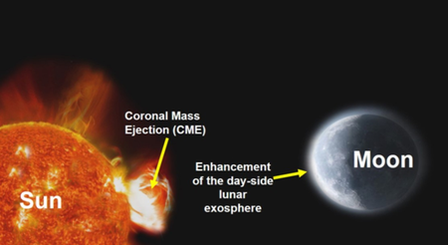Bengaluru, October 18 (IANS). India’s Chandrayaan-2 mission surprised space scientists around the world by revealing a scientific mystery. According to the Indian Space Research Organization (ISRO), Chandrayaan-2 recorded for the first time that the energy of the Coronal Mass Ejection (CME) from the Sun directly affects the Moon’s atmosphere. In a historic scientific breakthrough, the Indian Space Research Organization (ISRO) has announced that its Chandrayaan-2 has for the first time observed the effects of a coronal mass ejection (CME) from the Sun on the Moon’s exosphere. The observations were made using the Chandra Atmospheric Composition Explorer-2 (CHACE-2) instrument on board the orbiter. During a rare solar event on May 10, 2024, several CMEs impacted the Moon, causing a significant increase in the total pressure of the extremely thin atmosphere surrounding the Moon—the diurnal exosphere. ISRO scientists have reported that the density of neutral atoms and molecules in the exosphere has increased by more than an order of magnitude, confirming theoretical predictions that have never before been verified by direct observation. The Moon’s exosphere, classified as a surface boundary exosphere, is highly sensitive to solar activity due to the absence of a global magnetic field. The CME event increased the release of atoms from the lunar surface, temporarily changing the Moon’s atmospheric conditions. ISRO said these findings not only deepen the scientific understanding of lunar space weather, but also have implications for the design of future lunar missions and human habitats on the Moon. The study, titled ‘Impact of coronal mass ejections on lunar exosphere observed by CHACE-2 on Chandrayaan-2 orbiter’, was published in Geophysical Research Letters on August 16, 2025. ISRO said, “Earth’s Moon has a very thin atmosphere, which falls into the category of the ‘exosphere’ and a rare gas atoms, which means that the lunar atmosphere. interaction despite their coexist. The boundary of the exosphere is the surface of the moon and thus the moon’s exosphere falls into the category of ‘surface-boundary exosphere’.” It states that the exosphere on the Moon results from several processes, including the interaction of solar radiation, solar wind (hydrogen, helium and a small amount of heavy ions emitted by the Sun), and meteorite impacts on the Moon’s surface. These processes release atoms/molecules from the moon’s surface, which become part of the exosphere. ISRO said: “In general, the Moon’s exosphere is highly sensitive to even small changes in the factors responsible for its formation, and one such factor is coronal mass ejections from the Sun, called CMEs (abbreviated as Coronal Mass Ejections). CMEs are events when the Sun ejects significant amounts of its formation material, mostly helium and hydrogen effect on the Moon because it is an important effect on the moon and hydrogen. and also without any global magnetic field, the presence of which could (albeit partially) block solar impacts on its surface.” It said this opportunity to directly observe the impact of a CME on the Moon came as a rare event on May 10, 2024, when a series of coronal mass ejections (CMEs) were launched by the Sun. This increased amount of solar coronal mass falling on the Moon enhanced the process of stripping atoms from the lunar surface, releasing them into the lunar exosphere, which manifested as an increase in the total pressure in the sunlit lunar exosphere. — IANS MS/DKP
ISRO’s Chandrayaan-2 detects solar impact on Moon’s atmosphere
